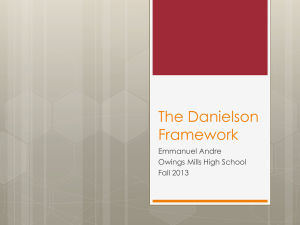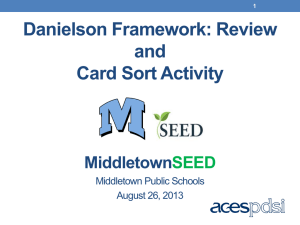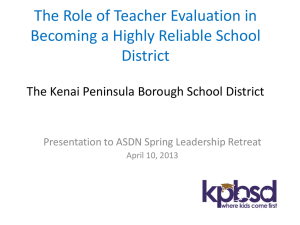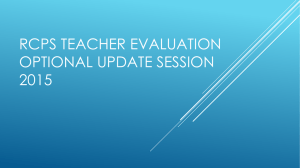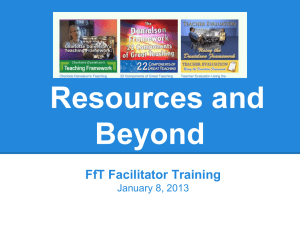The Framework for Teaching - Prince George's County Public
advertisement
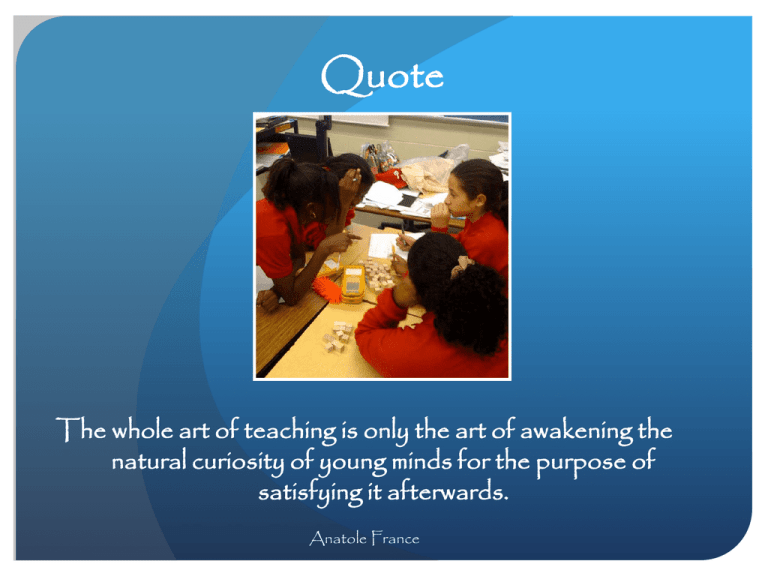
Quote The whole art of teaching is only the art of awakening the natural curiosity of young minds for the purpose of satisfying it afterwards. Anatole France Introduction to The Framework for Teaching Year 1 Prince George’s County Public Schools 2013 Workshop Objectives Overview of the FFT Build an initial familiarity with the FFT Become familiar with the domains, components, and elements Collaborate with Colleagues The Framework for Teaching Charlotte Danielson Agenda PART 1 Ice Breaker Establishing the Norms Review of the Framework for Teaching Review of the domains, components, and elements Wisdom of Practice Signers of the Declaration of Independence - Domain 3 Artifacts - Domains 1 & 4 PART 2 Debrief Questions and answers Reflection The Framework for Teaching Charlotte Danielson Scale of Familiarity The Framework for Teaching Charlotte Danielson You can Talk a Mile a Minute The subject is FFT The Framework for Teaching Charlotte Danielson You can Talk a Mile a Minute The subject is FFT Self Assessment Research Student Centered Cognitive Constructivist Reflective Domains observation The Framework for Teaching Charlotte Danielson You can Talk a Mile a Minute The subject is FFT Culture Question Planning and preparation Rigor Activity Discussion Turn and talk Professional responsibility The Framework for Teaching Charlotte Danielson Let’s Establish the NORMS P.E.M.D.A.S. The Order of Operations You have two minutes to use the letters from P.E.M.D.A.S. to create the norms for today's workshop. P.E.M.D.A.S. Participate fully, (put phones on vibrate) Exchange Ideas Make an Effort to Listen Dialogue equally, do your best Ask Questions, + Attitude Share your insight and support each other, self monitor, self reflect (sidebar conversations!) P.E.M.D.A.S. Expectation Please Engage in Meaningful Discussion with Active Self-reflection! Educational Setting 5 Minute Quick Write The Wisdom of Practice If you were to walk into a classroom, what might you see or hear there (from the students as well as the teacher) that would cause you to think that you were in the presence of an expert? What would make you think: “Oh, this is good; if I had a child this age, this is the class I would hope for.” Record at least six characteristics. Turn and Talk Share your characteristics with the group, combine those that are similar. The Framework for Teaching Charlotte Danielson Framework for Teaching Organization Domains (1, 2, 3, and 4) Components (8 Essentials) Elements (21) See page 3 and 4 The Domains 1: Planning and Preparation 2: The Classroom Environment 3: Instruction 4: Professional Responsibilities The Framework for Teaching Charlotte Danielson The Framework for Teaching a) b) c) d) e) f) a) b) c) d) e) f) Domain 1 Planning and Preparation Demonstrating Knowledge of Content and Pedagogy Demonstrating Knowledge of Students Setting Instructional Outcomes Demonstrating Knowledge of Resources Designing Coherent Instruction Designing Student Assessments Domain 4 Professional Responsibilities Reflecting on Teaching Maintaining Accurate Records Communicating with Families Participating in a Professional Community Growing and Developing Professionally Showing Professionalism a) b) c) d) e) a) b) c) d) e) f) Domain 2 The Classroom Environment Creating an Environment of Respect and Rapport Establishing a Culture for Learning Managing Classroom Procedures Managing Student Behavior Organizing Physical Space Domain 3 Instruction Communicating With Students Using Questioning and Discussion Techniques Engaging Students in Learning Using Assessment in Instruction Demonstrating Flexibility and Responsiveness The Framework for Teaching Charlotte Danielson Domain 1: Planning and Preparation a) Demonstrating Knowledge of Content and Pedagogy b) Demonstrating Knowledge of Students c) Setting Instructional Outcomes d) Demonstrating Knowledge of Resources e) Designing Coherent Instruction f) Designing Student Assessment The Framework for Teaching Charlotte Danielson Domain 1: Planning and Preparation a) Demonstrating Knowledge of Content and Pedagogy b) Demonstrating Knowledge of Students c) Setting Instructional Outcomes d) Demonstrating Knowledge of Resources e) Designing Coherent Instruction f) Designing Student Assessment The Framework for Teaching Charlotte Danielson Domain 2: The Classroom Environment a) Creating an Environment of Respect and Rapport b) Establishing a Culture for Learning c) Managing Classroom Procedures d) Managing Student Behavior e) Organizing Physical Space The Framework for Teaching Charlotte Danielson Domain 2: The Classroom Environment a) Creating an Environment of Respect and Rapport b) Establishing a Culture for Learning c) Managing Classroom Procedures d) Managing Student Behavior e) Organizing Physical Space The Framework for Teaching Charlotte Danielson Domain 3: Instruction a) Communicating with Students b) Using Questioning and Discussion Techniques c) Engaging Students in Learning d) Using Assessment in Instruction e) Demonstrating Flexibility and Responsiveness The Framework for Teaching Charlotte Danielson Domain 3: Instruction a) Communicating with Students b) Using Questioning and Discussion Techniques c) Engaging Students in Learning d) Using Assessment in Instruction e) Demonstrating Flexibility and Responsiveness The Framework for Teaching Charlotte Danielson Domain 4: Professional Responsibilities a) Reflecting on Teaching b) Maintaining Accurate Records c) Communicating with Families d) Participating in a Professional Community e) Growing and Developing Professionally f) Showing Professionalism The Framework for Teaching Charlotte Danielson Domain 4: Professional Responsibilities a) Reflecting on Teaching b) Maintaining Accurate Records c) Communicating with Families d) Participating in a Professional Community e) Growing and Developing Professionally f) Showing Professionalism The Framework for Teaching Charlotte Danielson The 8 Essential Components Domain 1: Domain 2: Planning and Preparation Classroom Environment 1c: Establishing Instructional Outcomes 2b: Establishing a Culture for Learning 1e: Designing Coherent Instruction 2d: Managing Student Behavior Domain 4: Domain 3: Professional Responsibility Instruction 4a: Reflecting on Teaching 3b: Using Questioning and Discussion Techniques 4c: Communicating with Families 3c: Engaging Student in Learning The Framework for Teaching Domain 1 Domain 2 Planning and Preparation The Classroom Environment Domain 4 Domain 3 Professional Responsibilities Instruction The Framework for Teaching Domain 1 Planning and Preparation •Demonstrating Knowledge of Content and Pedagogy •Demonstrating Knowledge of Students •Setting Instructional Outcomes •Demonstrating Knowledge of Resources •Designing Coherent Instruction •Designing Student Assessments Domain 4 Professional Responsibilities •Reflecting on Teaching •Maintaining Accurate Records •Communicating with Families •Participating in a Professional Community •Growing and Developing Professionally •Showing Professionalism Domain 2 The Classroom Environment •Creating an Environment of Respect and Rapport •Establishing a Culture for Learning •Managing Classroom Procedures •Managing Student Behavior •Organizing Physical Space Domain 3 Instruction •Communicating With Students •Using Questioning and Discussion •Techniques •Engaging Students in Learning •Using Assessment in Instruction •Demonstrating Flexibility and Responsiveness The Framework for Teaching Charlotte Danielson The Framework for Teaching Domain 1 Planning and Preparation •Demonstrating Knowledge of Content and Pedagogy •Demonstrating Knowledge of Students •Setting Instructional Outcomes •Demonstrating Knowledge of Resources •Designing Coherent Instruction •Designing Student Assessments Domain 4 Professional Responsibilities •Reflecting on Teaching •Maintaining Accurate Records •Communicating with Families •Participating in a Professional Community •Growing and Developing Professionally •Showing Professionalism Domain 2 The Classroom Environment •Creating an Environment of Respect and Rapport •Establishing a Culture for Learning •Managing Classroom Procedures •Managing Student Behavior •Organizing Physical Space Domain 3 Instruction •Communicating With Students •Using Questioning and Discussion •Techniques •Engaging Students in Learning •Using Assessment in Instruction •Demonstrating Flexibility and Responsiveness The Framework for Teaching Charlotte Danielson Domain 3: Instruction Component 3b: Questioning & Discussion Techniques Elements: Quality of Questions, Discussion Techniques, Student Participation Element Quality of Questions Discussion techniques Student participation Unsatisfactory Teacher’s questions are virtually all of poor quality, with low cognitive challenge and single correct responses, and they are asked in rapid succession Basic Teacher’s questions are a combination of low and high quality, posed in rapid succession. Only some invite a thoughtful response. Proficient Distinguished Most of the teacher’s questions are of high quality. Adequate time is provided for students to respond. Teacher’s questions are of uniformly high quality, with adequate time for students to respond. Students formulate many questions. Interaction between teacher and students is predominantly recitation style, with the teacher mediating all questions and answers. Teacher makes some attempt to engage students in genuine discussion rather than recitation, with \uneven results. Teacher creates a genuine discussion among students, stepping aside when appropriate. Students assume considerable responsibility for the success of the discussion, initiating topics and making unsolicited contributions. A few students dominate the discussion. Teacher attempts to engage all students in the discussion, but with only limited success. Teacher successfully engages all students in the discussion. Students themselves ensure that all voices are heard in the discussion Gallery Walk PTEM Results 2009-2010 How are you presently supporting your teachers in the setting instructional outcomes and questioning discussion techniques. UnSat Basic Prof Dist 1C 17 203 200 12 1E 17 146 266 12 2B 1 67 354 25 2D 3 117 313 13 3B 3 244 184 14 3C 1 182 245 14 Instruction Using Questioning and Discussion Techniques 3B 3% 1% UnSat Basic 41% 55% Prof Dist Priorities of the FFT The FFT has two priorities Cognitive engagement “minds-on” Constructivist learning “learning is done by the learner” Teaching cannot be considered Proficient or Distinguished if students are not thinking and doing the learning themselves. The Framework for Teaching Charlotte Danielson Signers of the Declaration of Independence When you look at the list of the signers of the declaration of independence, what questions come to mind? Develop a question that can be answered by reviewing the information on the paper, and another question that will extend the learning and engage students more cognitively. With your group create a method to present this investigation / learning to the students. The Framework for Teaching Charlotte Danielson Gallery Walk Let’s go on a learning walk and visit a a colleague’s classroom! Record the things that you see and hear. Simulated Hall Talk Share the things that you saw and heard. What evidence do you have that indicates cognitive engagement and constructivist instruction? Summary of A research-based definition of good teaching The Framework for Teaching A roadmap to, and navigation of, the territory A framework for novice-level practitioners, through accomplished teachers PGCPS Pilot Evaluation Collaboratively created by a team of teachers and administrators in 2007-08. Implemented by administrators and teachers in the 12 FIRST Pilot schools in 2008-09. Refined for use in the pilot program to be phased in at all Prince George’s County Public Schools in 2009-2010 2011-2012, 25% of teachers were observed using The Framework for Teaching (FFT) criteria to assess teacher quality The Prince George’s County Observation Process 2012-2013 Tenured Teachers FFT Observation Procedures 2012-2013 Step 1 Step 2 Self-Assessment Beginning-of-the-Year (By September 30th) Goal-Setting Conference First Formal Observation Step 3 Pre-Observation Conference Classroom Observation Post-Observation Conference Step 4 Step 5 Mid-Year Review (By the end of 1st Semester) Second Formal Observation (Completed during 2nd Semester) Pre-Observation Conference Classroom Observation Post-Observation Conference Second Self-Assessment Step 6 Step 7 Summative Evaluation Conference (After May 15th) Non-Tenured Teachers FFT and Tenured Teachers with Performance Issues Observation Procedures 2012-2013 Step 1 Step 2 Self-Assessment Beginning-of-the-Year (By September 15th) Goal-Setting Conference First Formal Observation Step 3 Pre-Observation Conference Classroom Observation Post-Observation Conference Step 4 Step 5 Second Formal Observation (Completed during 2nd Semester) Pre-Observation Conference Classroom Observation Post-Observation Conference Mid-Year Review (By the end of 1st Semester) Non-Tenured Teachers FFT and Tenured Teachers with Performance Issues Observation Procedures 2012-2013 Step 6 Step 7 Third Formal Observation (Completed in January or February) Pre-Observation Conference Classroom Observation Post-Observation Conference Fourth Formal Observation (Completed in March, April or May. Must be completed by May 21st) Pre-Observation Conference Classroom Observation Post-Observation Conference End of Year Self-Assessment (Completed in May or June) Step 8 Summative Evaluation Conference Step 9 (After May 15th) Formal Observations Observation lasts at least 30 minutes Focus will be on the 8 essential components Teacher completes the lesson reflection form within two work days of the observation and submits it to the administrator. Administrator provides the teacher with a rough draft of the Formal Observation Form with the marked Descriptors of Practice, with cited evidence, at the element level for the 8 essential components within 5 work days of the observation. Post Observation Conference The conference will be held within 5 work days of receiving the teacher’s reflection. Teacher may provide additional artifacts as follows: May present supporting evidence for [domains] 2 and 3 May demonstrate competency for the components not observed for domain 1 Administrator provides the teacher with a final copy of the Descriptors of Practice, with cited evidence, within 5 work days of the post-observation conference. Should demonstrate competency in the components not observed for domain 4. Mid Year Review Mid year reviews will be conducted using the Standards of Excellence evaluation tool. Summative Evaluation Conference The following topics may be reviewed: •The goals developed by the teacher and any evidence collected which demonstrates growth and attainment of the goals. •A review of the marked Descriptors of Practice from the 4 formal observations to determine growth and practice. •A review of the informal classroom observations and other evaluation inputs (such as student achievement data). Summative Evaluation Conference Discussion and debrief: Review the teachers’ goals and growth in the identified components of practice. Were the goals achieved and to what extent? What opportunities are needed for further growth in these components? What additional supports does the teacher perceive are needed to support growth? EXIT TICKET Complete the evaluation Complete the Scale Scale of Familiarity The Framework for Teaching Charlotte Danielson “The mediocre teacher tells The good teacher explains The superior teacher demonstrates The great teacher inspires” William Arthur Ward IN DEVELOPING YOUR PLAN CONSIDER Outcomes What do you want participants to walk away with Key learnings Themes Process How you will accomplish PD goals Engagement Rigor Differentiation Feedback How will you know if you met your goals

